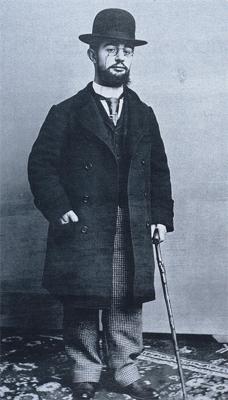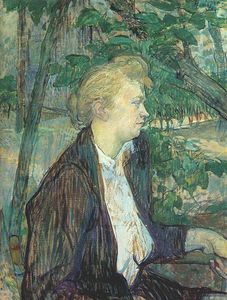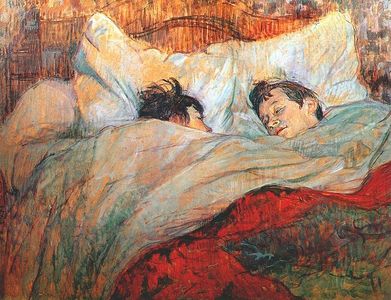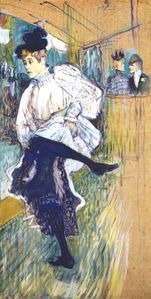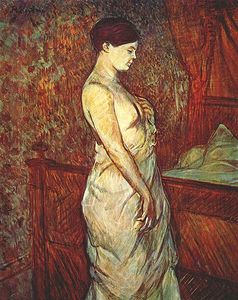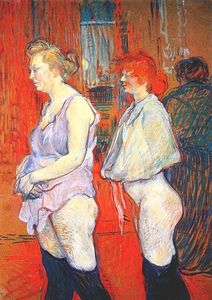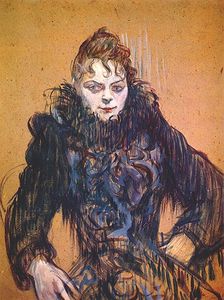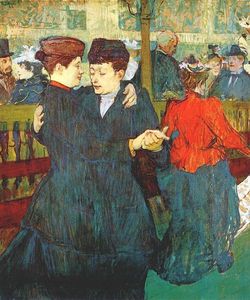Henri de Toulouse-Lautrec
Henri Marie Raymond de Toulouse-Lautrec-Monfa (24 November 1864 – 9 September 1901), also known as Henri de Toulouse-Lautrec (French: [ɑ̃"i də tuluz lot"ɛk]) was a French painter, printmaker, draughtsman and illustrator whose immersion in the colorful and theatrical life of Paris in the late 19th century allowed him to produce a collection of enticing, elegant and provocative images of the modern, sometimes decadent, life of those times. Toulouse-Lautrec is among the best-known painters of the Post-Impressionist period, with Cézanne, Van Gogh and Gauguin. In a 2005 auction at Christie's auction house, La Blanchisseuse, his early painting of a young laundress, sold for US$22.4 million and set a new record for the artist for a price at auction.
London
Henri de Toulouse-Lautrec's family were Anglophiles, so, though not as fluent as he pretended to be, he spoke English well enough to travel to London. He was commissioned by the J.& E. Bella company to make a poster advertising their confetti (which was banned after the 1892 Mardi Gras) and the bicycle advert La Chaîne Simpson.
While in London, he met and befriended Oscar Wilde. When Wilde faced imprisonment in Britain, Toulouse-Lautrec became a very vocal supporter of his and his portrait of Oscar Wilde was painted the same year as Wilde's trial.
Alcoholism and prostitution
Toulouse-Lautrec was mocked for his short stature and physical appearance, which led him to drown his sorrows in alcohol.
He initially only drank beer and wine, but his tastes expanded into hard liquor, namely absinthe. The cocktail Earthquake (Tremblement de Terre) is attributed to Toulouse-Lautrec: a potent mixture containing half absinthe and half cognac in a wine goblet. To ensure he was never without alcohol, Toulouse-Lautrec hollowed out his cane (which he needed to walk due to his underdeveloped legs) and filled it with liquor.
In addition to his growing alcoholism, Toulouse-Lautrec also frequented prostitutes. Toulouse-Lautrec was fascinated by their lifestyle and the lifestyle of the "urban underclass" and incorporated those characters into his paintings. Fellow painter Édouard Vuillard later said that while Toulouse-Lautrec did engage in sex with prostitutes, "the real reasons for his behavior were moral ones [...] Lautrec was too proud to submit to his lot, as a physical freak, an aristocrat cut off from his kind by his grotesque appearance. He found an affinity between his own condition and the moral penury of the prostitute."
Cooking skills
A fine and hospitable cook, Toulouse-Lautrec built up a collection of favorite recipes – some original, some adapted – which would be posthumously published by his friend and dealer Maurice Joyant as L'Art de la Cuisine. The book was republished in English translation in 1966 as The Art of Cookery - a tribute to his inventive (and wide-ranging) cooking.
- Works by Toulouse-Lautrec
Death
By February 1899, Toulouse-Lautrec's alcoholism began to take its toll and he collapsed due to exhaustion and the effects of alcoholism. His family had him committed to Folie Saint-James, a sanatorium in Neuilly for three months. While he was committed, Toulouse-Lautrec drew 39 circus portraits. After his release, Toulouse-Lautrec returned to the Paris studio for a time and then traveled throughout France. His physical and mental health began to decline rapidly due to alcoholism and syphilis, which he reportedly contracted from Rosa La Rouge, a prostitute who was the subject of several of his paintings.
On 9 September 1901, at the age of 36, he died from complications due to alcoholism and syphilis at his mother's estate, Château Malromé in Saint-André-du-Bois. He is buried in Cimetière de Verdelais, Gironde, a few kilometers from the estate. Toulouse-Lautrec's last words reportedly were "Le vieux con!" ("the old fool"), his goodbye to his father, though another version has been suggested, in which he used the word "hallali", a term used by huntsmen at the moment the hounds kill their prey: "Je savais, papa, que vous ne manqueriez pas l'hallali" ("I knew, papa, that you wouldn't miss the death.").
After Toulouse-Lautrec's death, his mother, the Comtesse Adèle de Toulouse-Lautrec, and his art dealer, Maurice Joyant, continued promoting his artwork. His mother contributed funds for a museum to be created in Albi, his birthplace, to show his works. This Musée Toulouse-Lautrec owns the largest collection of works by Henri de Toulouse-Lautrec.
Art
In his less-than-20-year career, Toulouse-Lautrec created:
- 737 canvased paintings
- 275 watercolors
- 363 prints and posters
- 5,084 drawings
- some ceramic and stained glass work
- an unknown number of lost works[8]
His debt to the Impressionists, particularly the more figurative painters like Manet and Degas, is apparent, for, within his works, one can draw parallels to the detached barmaid at A Bar at the Folies-Bergère by Manet and the behind-the-scenes ballet dancers of Degas. His style was also influenced by the classical Japanese wood prints which became popular in art circles in Paris.
He excelled at depicting people in their working environments, with the color and movement of the gaudy nightlife present but the glamour stripped away. He was a master at painting crowd scenes where each figure was highly individualized. At the time they were painted, the individual figures in his larger paintings could be identified by silhouette alone, and the names of many of these characters have been recorded. His treatment of his subject matter, whether as portraits, in scenes of Parisian nightlife, or as intimate studies, has been described as alternately "sympathetic" and "dispassionate".
Toulouse-Lautrec's skilled depiction of people relied on his painterly style, which is highly linear and emphasizes contour. He often applied paint in long, thin brushstrokes which would leave much of the board underneath showing through. Many of his works may be best described as "drawings in colored paint
- More information is available at [ Wikipedia:Henri_de_Toulouse-Lautrec ]
Chat rooms • What links here • Copyright info • Contact information • Category:Root
